

Documentaries. Place and space, as they relate to mind, body, and culture. Psychogeography - Mythogeography - Deep Topology - Street Haunting. StAllio!'s way. Welcome to part 2 of my databending primer!

Sorry about the lengthy delay between part 1 of this primer and part 2. if you haven't already read part 1, you may want to do so, as part 2 depends on various terms and concepts that were introduced in part 1. this part is about sonification, and about databending with audio software. i'll show you how to coax databent sounds out of your windows hard drive using a type of audio software called a wav editor. then, i'll give you some tips for using the wav editor to create databent images. sonification, put simply, is the act of converting data into sound. wikipedia points to some well-known examples, such as the geiger counter and sonar. it's an extremely broad field; here i'll be focusing on sonification in a databending context, or using sonification techniques to create art. techniques one simple way to sonify data is to convert it to MIDI.
Opening files in a wav editor. StAllio!'s way: databending and glitch art primer, part 1: the wordpad effect. Welcome to my databending and glitch art primer! In part 1, we're going to talk about one of my favorite glitch art effects—the wordpad effect. i'm starting off with this effect because it's so easy that any windows user should be able to do it (note: i haven't tried it in vista), but it's complex enough under-the-hood that it allows me to discuss several important principles of glitch art. but first, let's define a few terms. databending is, in essence, the artistic misuse of digital information. the term is inspired by the similar art of circuit bending ; you could say that databending is like circuit bending with no circuits. the term is used most frequently in the context of electronic music (primarily glitch music ). the most common types of databending are: the wordpad effect: the wordpad effect is a simple glitch effect i discovered a couple years back, with the help of my readers . here's how it works: you take a digital photo like this: pretty dramatic results, eh?
Category:History of the United States by ethnic group. Structural abuse. Structural abuse is the process by which an individual is dealt with unfairly by a system of harm in ways that the person cannot protect themselves against, cannot deal with, cannot break out of, cannot mobilise against, cannot seek justice for, cannot redress, cannot avoid, cannot reverse and cannot change.
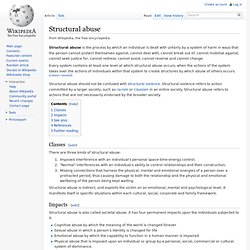
Every system contains at least one level at which structural abuse occurs, when the actions of the system takes over the actions of individuals within that system to create structures by which abuse of others occurs. [citation needed] Structural abuse should not be confused with structural violence. Structural violence refers to action committed by a larger society, such as racism or classism in an entire society. Structural abuse refers to actions that are not necessarily endorsed by the broader society. Classes[edit] Group psychological abuse. Group psychological abuse is psychological abuse done by groups to their members.
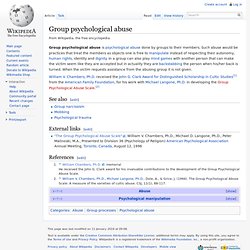
Such abuse would be practices that treat the members as objects one is free to manipulate instead of respecting their autonomy, human rights, identity and dignity. In a group can also play mind games with another person that can make the victim seem like they are accepted but in actuality they are backstabbing the person when his/her back is turned. When the victim requests assistance from the abusing group it is not given. William V. Chambers, Ph.D. received the John G. See also[edit] External links[edit] "The Group Psychological Abuse Scale", William V.
References[edit] Jump up ^ William Chambers, Ph.D., memorial He received the John G. Crowd manipulation. Crowd manipulation is the intentional use of techniques based on the principles of crowd psychology to engage, control, or influence the desires of a crowd in order to direct its behavior toward a specific action.[1] This practice is common to politics and business and can facilitate the approval or disapproval or indifference to a person, policy, or product.
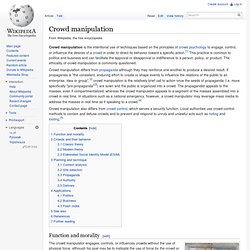
The ethicality of crowd manipulation is commonly questioned. Crowd manipulation differs from propaganda although they may reinforce one another to produce a desired result. If propaganda is "the consistent, enduring effort to create or shape events to influence the relations of the public to an enterprise, idea or group",[2] crowd manipulation is the relatively brief call to action once the seeds of propaganda (i.e. more specifically "pre-propaganda"[3]) are sown and the public is organized into a crowd. Crowd manipulation also differs from crowd control, which serves a security function. Function and morality[edit] Jodi (art collective) Jodi, or jodi.org, is a collective of two internet artists: Joan Heemskerk (born 1968 in Kaatsheuvel, the Netherlands) and Dirk Paesmans (born 1965 in Brussels, Belgium).
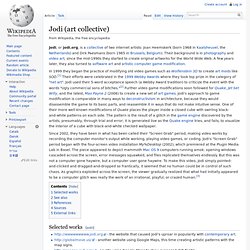
Their background is in photography and video art; since the mid-1990s they started to create original artworks for the World Wide Web. A few years later, they also turned to software art and artistic computer game modification. Since 2002, they have been in what has been called their "Screen Grab" period, making video works by recording the computer monitor's output while working, playing video games, or coding. Jodi's "Screen Grab" period began with the four-screen video installation My%Desktop (2002), which premiered at the Plugin Media Lab in Basel. The piece appeared to depict mammoth Mac OS 9 computers running amok: opening windows cascaded across the screen, error messages squawked, and files replicated themselves endlessly.
Behaviour Change Toolkit. Behaviour Change Toolkit As part of my work with Good Energy I have been learning why people behave the way they do, and what tools we have to help them change behavior.
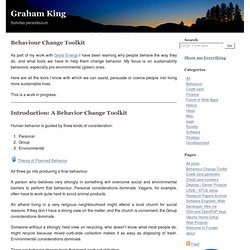
My focus is on sustainability behaviors, especially pro-environmental (green) ones. Theory of planned behavior. In psychology, the theory of planned behavior is a theory about the link between beliefs and behavior.
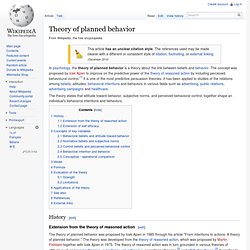
The concept was proposed by Icek Ajzen to improve on the predictive power of the theory of reasoned action by including perceived behavioural control.[1] It is one of the most predictive persuasion theories. It has been applied to studies of the relations among beliefs, attitudes, behavioral intentions and behaviors in various fields such as advertising, public relations, advertising campaigns and healthcare. The theory states that attitude toward behavior, subjective norms, and perceived behavioral control, together shape an individual's behavioral intentions and behaviors. History[edit] Extension from the theory of reasoned action[edit] The theory of planned behavior was proposed by Icek Ajzen in 1985 through his article "From intentions to actions: A theory of planned behavior. " Extension of self-efficacy[edit] Concepts of key variables[edit] Normative beliefs and subjective norms[edit]